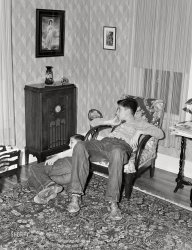
MAY CONTAIN NUTS

Search Shorpy
SHORPY ART

Framed or unframed, desk size to sofa size, printed by us in Arizona and Alabama since 2007. Explore now.
Join and Share
Ad-Free Shorpy
Shorpy is funded by you. Patreon contributors get an ad-free experience.
Learn more.

Recent comments
- Indiana Harbor Belt abides
- Freezing haze
- Corrections (for those who care)
- C&NW at Nelson
- Fallen Flags
- A dangerous job made worse
- Water Stop
- Passenger trains have right of way over freights?
- Coal
- Never ceases to amaze me.
- Still chuggin' (in model form)
- Great shot
- Westerly Breeze
- For the men, a trapeze
- Tickled
- Sense of loneliness ...
- 2 cents
- Charm City
- What an Outrage
- Brighton Park
- Catenary Supports
- Just a Little Before I was Born
- Afternoon normal
- The Flat Iron Cafe survives
- Aging in Place
- Raise your hand
- Good and Bad
- Oh, the 70's
- Nooooooi
- The aluminum tubing
Member Photos
The Shorpy
Print Emporium
Print Emporium
Search Shorpy
Search results -- 30 results per page
- Brownsville: 1938
- ... Medium format acetate negative by Sheldon Dick for the Farm Security Administration. View full size.
Raw So when was paint ... Posted by Dave - 11/05/2020 - 11:18am -
![Brownsville: 1938 1938. "Shenandoah, Pennsylvania. Miner's home in the Brownsville sector." Medium format acetate negative by Sheldon Dick for the Farm Security Administration. View full size.
RawSo when was paint invented?
Cuteness beneath the corbelsThat's a darling smile shining from the sweet face of the elder of the two tots in the upper left-hand window. This place looks to be pretty nice given the situation. Madame behind door on the right cared enough to put a pretty fringed shade in the window of said door. I hope it was warm within those walls when the winter winds blew.
Pre lawyer days.Injuries possible everywhere you turn.
Narrow StreetsI "drove" around Shenandoah, and found some of the narrowest streets I've seen. Maybe someone can tell me the reason for this.
Single or Duplex?Is this a single family residence or for two families?
2 sets of stairs
2 entrance doors
2 doors to what is probably lower cellar area(s)
But only 1 of something that could be a mailbox next to the left entrance door.
How many families could live in one house.It could be upper and lower apartments or one side is a smaller apartment for a smaller family. There is a side door on at least one side so the building could be divided into even smaller spaces or rambles on like the house on the left. It isn't clear if these are company homes which weren't known to be overly generous to employees.
Paint, shmaintLooks like an example of the saying, "Too poor to paint, too proud to whitewash." Even so, they appear to have done what they could in upkeep. I would hazard a guess that the home's residents were tenants rather than owners, and were, thus, at the tender mercies of the landlord as far as painting and such.
My mum's family was from BrownsvilleI watched the town board up businesses throughout the late '60s and '70s. It was nearly a ghost town.
Always knew I was close to Grandma's house when saw Nemacolin Castle.
[That's a different Brownsville (scroll up). - Dave]
Shenandoah, birthplace of Tommy and Jimmy DorseyI am surprised our dedicated Shorpy sleuths did not dig deep enough to reveal this fact.
Brownsville vs. Brownsville SectionThis photo shows the Brownsville section of Shenandoah, which is in Schuykill County, in the eastern half of the state. The nearest city of size is Allentown. The Brownsville with Nemacolin Castle is in Fayette County, in southwestern Pennsylvania, and the nearest "big" city is Pittsburgh.
It's how you finishThe comment by dddlensman triggered my memory of visiting and photographing the very beautiful gravesite of Tommy Dorsey, "The Sentimental Gentleman," on November 1, 2019, at Kensico Cemetery, Valhalla, New York. Incidentally, the page lists his place of birth as Mahanoy Plane, Schuylkill County (close enough):
https://www.findagrave.com/memorial/292/tommy-dorsey
(The Gallery, Kids, Mining, Sheldon Dick)](https://www.shorpy.com/files/images/SHORPY-8c02374a.thumbnail.jpg)
- Ninth Street: 1940
- ... full size. 35mm nitrate negative by John Vachon for the Farm Security Administration.
Quiet Street Scenes I love quiet street views ... Posted by Dave - 09/11/2011 - 10:39am -
![Ninth Street: 1940 May 1940. "Residential street in Woodbine, Iowa." View full size. 35mm nitrate negative by John Vachon for the Farm Security Administration.
Quiet Street ScenesI love quiet street views like this and also the city shot that is next. It places you as a pedestrian on the same street. This shot has a calm old-fashioned quality I really like, and I appreciate the chance to see an "average" street where people like my grandparents lived their lives.
WoodbineNinth Street is not very long. This might be at Ely Street. It's hard to read the sign turned away from the camera. The Ninth Street sign is a great example of button copy, where smaller round reflectors would be fitted inside the white text. US 30 passes through town. Lincoln Street is likely the original Lincoln Highway. Nowadays the utility pole and signs would be behind the curb. I'm not sure what to make of that sidewalk.
Ninth Street House for SaleAccording to Zillow there's a house for sale on Ninth Street in Woodbine for $57,000. That's a bargain by Connecticut standards except it's for sale by HUD suggesting it's a foreclosure situation with the house being in unknown condition.
Might be ElyI futzed with the levels and curves in Photoshop, but I don't have enough pixels. Can we get a zoom?
Odd, but the sun looks like it's coming from behind and to our left, which would make that direction South (if it's high noon), but 9th St. runs East-West. We don't know if the sign was just pushed and twisted a little or a lot. Google Earth's images of Woodbine are fairly good res.
[Look again. The lady is walking along Ely (or whatever) Street. Ninth is perpendicular to the shadow cast by the pole. The left edge of the Ely sign is closer than the right (the ST half is pointing away from us). - Dave]
Iowa HousesThis past summer my I had to go back to Iowa to sell my father's house. It was an absolutely charming craftsman (built in shelves & other wood details, original beveled glass in several windows & exterior doors, etc.), hip roof, porch), 2 bedroom, in fine shape and sold for $39K. The same house where I live now, Ithaca, NY, would be at least 150+ K more. It's possible to get a very nice house in Iowa for very little money.
901 ElyI can't make out the house number for the house on the corner, but it sure looks like this house that's for sale, at 901 Ely Street, Woodbine IA 51579, which is at the corner of Ely and Ninth.
http://www.zillow.com/Gallery.htm?zpid=2146016195
And when you go to Google Maps, you can see the faint outline of the diagonal sidewalk, from the house to the corner.
The house has a pending sale, listed at $24,900. A house with a little unknown history.
Sign in the YardDid you notice the small sign in the yard? Along the sidewalk, left of the tree trunk. Wonder what it says. Room for rent? Sewing? Laundry?](https://www.shorpy.com/files/images/8a05723u.thumbnail.jpg)
- The Snowville Seven: 1940
- August 1940. "Mormon farm family. Snowville, Utah." Medium format acetate negative by Russell Lee for the Farm Security Administration. View full size.
There she is The little girl from ... Posted by Dave - 09/14/2020 - 5:58pm -
![The Snowville Seven: 1940 August 1940. "Mormon farm family. Snowville, Utah." Medium format acetate negative by Russell Lee for the Farm Security Administration. View full size.
There she isThe little girl from Pride of Plates, who was putting away dishes in the grubby kitchen! She's still wearing those awful socks and so is her sister. Maybe that's all they had. She's very cute (though she has her mother's nose.) She also seems to be the one with the most personality. All the other children look a little subdued.
I wonder if any of them are yet living.
[Not after they read this! - Dave]
The Story in the ShoesTheir footwear tells the story of the photo shoot. The farmer and his son clearly work outdoors, and so does the mother, oftentimes. The little girl on Daddy's lap followed them outside. They came indoors for the photos. The two sisters on the left stayed in the house, cleaning and minding the baby. Elementary.
Bloomin'!Are those bloomers peeking out from under Mother's dress?
Temple GarmentsIt looks like you can barely make out the temple garments that the wife is wearing under her dress. She and her husband probably had a celestial marriage in the nearest Mormon Temple which would require them to undergo the endowment ceremony. After that they are required to wear their temple garments at all times. I first saw them when I was in the army. There was a soldier from the almost entirely Mormon town of Fredonia in Arizona that wore them and sort of explained what they were when other soldiers asked.
I know I misspelled Mormonin my previous comment. Maybe I'll have a chance to correct it!
[Not to mention "misspelled." - Dave]
Ouch!
Faces Full of CharacterAnd kindness, too. I don't see any evidence of poverty, as reflected in their socks and shoes. They're merely practicing thrift: "Use it up, wear it out", etc. The kids all have chores, either inside or outside of the house. The family looks happy and contented. Looking at their photo in their immaculate house, I rather envy them.
Good character outclasses a Hollywood nose every time.
We're Younger Than We LookGoing by the ages of the children, and the usual practice of marrying quite young in that era, the parents are probably not much older than early 30s. A hard, yet contented life, no doubt.
The children have classic good looks, most would be in their 90s now - wonder how many still alive?
(The Gallery, Agriculture, Kids, Russell Lee)](https://www.shorpy.com/files/images/SHORPY-8b25880a.thumbnail.jpg)
- Hi-Way Tavern: 1939
- ... Medium format acetate negative by Russell Lee for the Farm Security Administration. View full size.
Sign of a woman Always nice ... Posted by Dave - 03/07/2018 - 11:02am -
![Hi-Way Tavern: 1939 March 1939. "Signs in front of highway tavern. Crystal City, Texas." And, somewhere back there amid the signage, a gas station. Medium format acetate negative by Russell Lee for the Farm Security Administration. View full size.
Sign of a womanAlways nice to see a woman's touch. The family must live upstairs; hence the potted plant and a towel hanging on the line.
Home of Popeye the SailorAt the time, Crystal City's main economic engine was the cultivation of spinach, and March of 1939 was the two year anniversary of the installation in front of city hall of the statue of Popeye the Sailor. The statue was erected to celebrate the economic contribution of spinach to the local economy, which was especially important to the city during the Depression. The statue still stands, and Crystal City hosts the annual Spinach Festival every November.
https://www.roadsideamerica.com/story/2658
Blatz BeerWhen you're drinking for Quantity not Quality.
Color me impressedThis would be a good candidate for colorization.
Delaware PunchI haven't had a Delaware Punch in decades. Do they still make that?
Long-lasting brands!Let's see:
7up - check
Dr. Pepper - check
Delaware Punch - check
Coca-Cola - check
Budweiser - check
Pearl beer - check
Blatz beer - check
Gulf oil - check
I believe the only brand name not in use today is Grand Prize beer. Pretty impressive 8 for 9 in an 80-year-old photo!!
[Or 9 for 10 if we count the Orange Crush sign. - Dave]
Very collectible signs, allAny collectors want to estimate the combined value of all those signs in today's market?
OK, I give up.Where's the Orange Crush?
[Between the 7ups. -tterrace]
Although I do spy half of a Nehi sign in the shadows (left of Blatz Beer).
Add NehiThat makes 10/11.
Never Heard This One BeforeFound out that Delaware Punch was named for one of its main ingredients, the Delaware grape. Then found out the Delaware grape is named for Delaware County, Ohio, where it was first grown--and where I happen to live.
I Am SaddenedThey don't have Squirt advertised. Very popular during the early and middle 40's. But Squirt wasn't made until about 1938 so, maybe, the popularity of the soda had not made its way to this location yet in 1939.
Grand Prize not so grandMy grandfather worked for a Grand Prize distributor in southeast Texas in the 1950s and he always said its taste left a lot to be desired. As Pennsylvaniaproud said, quantity over quality.
On a side note, the Gulf Brewing Company, makers of Grand Prize, was once owned by Howard Hughes.
(The Gallery, Eateries & Bars, Gas Stations, Rural America, Russell Lee)](https://www.shorpy.com/files/images/SHORPY-8b21169a.thumbnail.jpg)
- Zell Hall: 1942
- ... Originally from Minnesota, Vachon started out with the Farm Security Administration as a temporary clerk in Washington, DC, maintaining "The File," ... Posted by Dave - 10/19/2021 - 2:37pm -
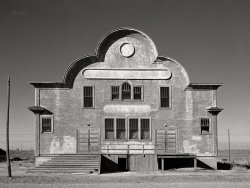
- Government Mules: 1939
- ... "Ernest W. Kirk Jr., whose team of mules was bought with a Farm Security Administration loan. Near Ordway, Colorado." Medium format negative by ... Posted by Dave - 08/26/2018 - 4:59pm -
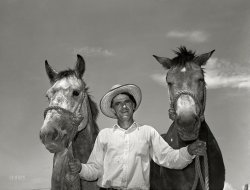
- Leadville Deluxe: 1941
- ... format acetate negative by Marion Post Wolcott for the Farm Security Administration. View full size.
The '41 Oldsmobile ... ... Posted by Dave - 03/09/2022 - 12:41pm -
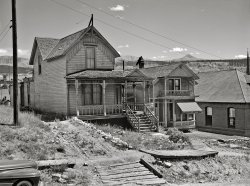
- Pittsburgh Posts: 1941
- ... Medium format acetate negative by John Vachon for the Farm Security Administration. View full size.
Is the circus in town? What ... Posted by Dave - 06/06/2020 - 12:53pm -
![Pittsburgh Posts: 1941 June 1941. "Rain. Pittsburgh, Pennsylvania." Medium format acetate negative by John Vachon for the Farm Security Administration. View full size.
Is the circus in town?What is that large tent filling the street a block ahead?
Ah, I see nowIt's an awning on the next porch.
A thousand words?This is a picture you can hear.
DepthConsidering the light level, Vachon has achieved great depth of field without resorting to a slow shutter speed (man and umbrella in motion not blurred). I view in awe. Camera? Rollieflex?
Great Cars!Facing us across the street is a 1935 Chevrolet. The third car, facing us, is a 1940 Chevrolet. The first car facing us on the right is a 1936 Ford.
Bonus lovelinessThe abacus motif of the transom grill directly above the porch rail is just plain beautiful.
Posts and balusters still there!Astute Shorpy followers will notice that the fragment of column on the far left is the same column as the one seen in a different view posted in June 2008:
https://www.shorpy.com/node/3793
The location was identified in a comment as being on the corner of Madison and Lockhart. Here's the same view from the same location today:
https://goo.gl/maps/J1xaf8nmE5AJNUQ87
Posts and balusters are still present at this location. The lack of spindlework causes it to lose some of its old charm, in my opinion.
Ticket TimeParking left wheels to curb brings a parking ticket nearly everywhere. Well, except in England, of course.
Depth of FieldI had the same reaction that ManyBuicks did. I shoot with several twin lens reflex cameras from the 1930s, so I experimented a bit. I fastened a piece of frosted mylar at the film plane of my 1937 Ikoflex (identical to one used by Jack Delano) and sighted across the facade of my row of townhouses. At f/8 the depth of field was barely adequate, and not nearly as good as in Vachon’s rain shot. Considering that the original photo was probably shot at about 1/50 second (common on cameras of that era) to almost stop the walker, and the day was quite dark, I think that would have required film with an unrealistically high ASA speed, especially for those years.
Then I found the original scan at the Library of Congress. The film was medium format, alright, but it was sheet film. (The notch codes are visible.) That means that Vachon could have used a 2x3 Speed Graphic camera. They don’t have a front swing movement for the lens, but by dropping the bed and holding the camera sidewise, you can achieve the same result.
However he did it, John Vachon knew what he was doing.
[The film size is 4¼ x 3¼ inches. --Dave]
Singing In The RainJust, singing in the rain. What a glorious feeling.
Thanks to the keen eye of davidk I am also mesmerized by the abacus motif.
A distinction without a differenceSagebrushCity might have missed the format size of the camera, but everything else he posited Vachon doing could have been done just as well with a 4¼ x 3¼ Graphic, which also existed at the time (I used to have one).
(The Gallery, Cars, Trucks, Buses, John Vachon, Pittsburgh)](https://www.shorpy.com/files/images/SHORPY-8c19404a.thumbnail.jpg)
- Hollywood and Vine: 1939
- ... week's bill." 35mm nitrate negative by John Vachon for the Farm Security Administration. View full size.
Poster collectors I checked ... Posted by Dave - 05/18/2011 - 9:53pm -
![Hollywood and Vine: 1939 September 1939. Cadott, Wisconsin. "The week's bill." 35mm nitrate negative by John Vachon for the Farm Security Administration. View full size.
Poster collectorsI checked some auction prices for these one-sheet movie posters, and came up with three:
Susannah of the Mounties $134 (2009)
Stronger than Desire $45 (2006)
Andy Hardy Gets Spring Fever $120 (2008)
The ringer is the Gracie Allen. I couldn't find any references or images of this particular design, but many for a different one whose estimates range up to $1700, so perhaps the one here is a real rarity.
"Vine." I get it.
LongevityMore than seven decades later, the stars of two of these movies are still among us: Mickey Rooney (going on 91) and Shirley Temple (83).
Stanley's Selection1939 was one of the greatest years ever for movies - i.e. Gone With the Wind, The Wizard of Oz, Dark Victory, Stagecoach, Mr. Smith Goes to Washington, Wuthering Heights, etc. - and the Stanley Theatre isn't showing even one of them!
Not Exactly First-RunAs with most small town movie houses, it looks like Cadott's Stanley Theatre was not very high up in the pecking order for new releases. According to IMDB, "Susannah of the Mounties" was released on June 13, 1939, "The Gracie Allen Murder Case" on June 2, "Stronger Than Desire" on June 30, and "Andy Hardy Gets Spring Fever" on July 21. Any Cadott residents who burned to see the latest movies might have made the nearly 100-mile trek to Minneapolis for quicker gratification.
Some of the hit movies mentioned below had been released in the Spring, but "The Wizard of Oz" didn't hit the screens until August 25 - sit tight, Cadott - and everyone was going to have to wait a bit longer for "Gone With the Wind." Although it premiered in December, it was not actually distributed to theaters until January 17, 1940.
Gracie Allen Murder CaseMy mother had a set of S.S. Van Dine's Philo Vance murder mysteries, gray covers with a spiderweb design. One of them was The Gracie Allen Murder Case. Philo was a rich guy of the "old boy, my dear chap" school whose valet assisted him in his investigations. I recall that many of the chapters began with epigrams in Latin or Greek and Philo was always tossing in "bon mots" in French.
Pre-TV WorldAs someone who has grown up in a post-television world, I find it fascinating how so many movies could be at one single screen theater over the course of 10 days. Hope you don't have any plans Tuesday night because that is the last night for "Susannah of the Mounties"!
On another note, what is a "bank-nite" and why is touted as being special?
[The signs say "Book Night." A promotional stunt dreamed up by exhibitor Robert Lippert. - Dave]
I did see that sign, but what I was referring to was written next to the Wed & Thurs above the Gracie Allen Murder Case poster.
Top BillingLewis Stone over Mickey Rooney
Gracie Allen over Kent Taylor
What were they thinking?
Now PlayingThe Stanley Theater is still open and playing films. I've had the pleasure myself, actually.
Daniel "Mussy" Eslinger and his family have been running the theater since 1968. In 2010, the family restored the outside of the theater to its 1936 glory.
The theater is a gem and so is Mussy. Where else can you get real butter on your popcorn?
Bank NiteBank Night (listed on the Wed-Thurs board as "Bank Nite") was a lottery for prizes which theaters held during the latter part of The Depression in order to get more patrons into their theater.
WallpaperThis picture would be the perfect 'wallpaper' for a fan of classical movies. I wonder if TCM has any of these flicks in their vault. I'd like to see the 'Gracie Allen' picture; note that George Burns isn't mentioned. Interesting.
(The Gallery, John Vachon, Movies)](https://www.shorpy.com/files/images/8a04849a.thumbnail.jpg)
- On the Town: 1936
- ... full size. 35mm nitrate negative by Theodor Jung for the Farm Security Administration.
Let's go out on a limb... and say it was ... Posted by Dave - 12/20/2007 - 1:24am -
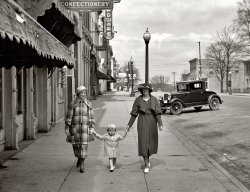
- Mitiguy Hardware: 1941
- ... Medium format acetate negative by Jack Delano for the Farm Security Administration. View full size.
Wouldn't You Really ... Posted by Dave - 10/07/2021 - 1:48pm -
![Mitiguy Hardware: 1941 September 1941. "South Royalton, Vermont. The main street." Medium format acetate negative by Jack Delano for the Farm Security Administration. View full size.
Wouldn't You Really Rather Have a Buick?I'm usually not that good at identifying pre-1950 cars, but I do believe that great looking black sedan is a 1941 Buick.
The most interesting gasoline station I have ever seen.I have NEVER seen a gasoline station right in the middle of the block like that. That is quite uniquely strange. Also, this is the earliest instance of a credit card being mentioned that I have ever seen as well. Double interestingness there.
And the monument is still there but the quirky gasoline station is gone.
[That "monument" is a horse fountain. More curbside gasoline here. - Dave]
Dobbin knows ---- just ask him.
Allegedly that round road menace is a watering trough. Amazingly -- even for Vermont, one adds (snidely) -- it's still there.
Ya gotta water your horse at home nowHere's the Google street view. The Mobil gas station is now a thrift store. The nearest gas pump I could locate is now about a quarter-mile behind where Jack Delano was standing, down Chelsea Street on the other side of White River. There are railroad tracks where this group of buildings end. The horse trough was probably placed there because the town square is across the street from these buildings. It's now planted with flowers. Looking around on Google maps I was surprised to see nearby White River Valley High School has three soccer fields and baseball diamonds, but no football field.
80 years later, oddly enough (or not), there are still several thousand lodges worldwide, and the local IOOF still draws enough members to hold twice-monthly meetings.
Chelsea Station and Odd FellowsI noticed in Doug's Google Maps view of the current location that the awning says "Chelsea Station." I wonder if that's a nod to it's its former role as a filling station. Additionally, it appears the The Independent Order of Odd Fellows still occupies the second floor above the hardware store.
Two Forms of Filling UpWater for your horses and fuel for your car. One free, one quite pricey.
(The Gallery, Gas Stations, Jack Delano, Small Towns, Stores & Markets)](https://www.shorpy.com/files/images/SHORPY-8c07142a.thumbnail.jpg)
- Dare Ya: 1940
- ... Medium format acetate negative by John Vachon for the Farm Security Administration. View full size.
South Wind South Wind made ... Posted by Dave - 12/21/2019 - 12:34pm -
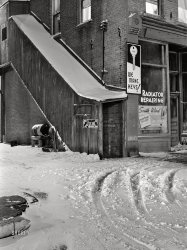
- Rear Window: 1938
- ... 35mm nitrate negative by Arthur Rothstein for the Farm Security Administration. View full size.
Get away from that hole! ... Posted by Dave - 08/03/2012 - 1:29pm -
![Rear Window: 1938 July 1938. "Slums in Pittsburgh, Pennsylvania." 35mm nitrate negative by Arthur Rothstein for the Farm Security Administration. View full size.
Get away from that hole!The boys seem to be milling about waiting for their friend Vinny to come out of the hole in the ground; what is that, a foundation for an old outhouse, now a garbage heap?
The HillFrom the looks of this, it was probably taken somewhere in Pittsburgh Hill district.
Handy gadgetI like the multi-arm clothes dryer -- energy efficient I'd say.
Room With a ViewLooks like a meal on the table in the second floor window on the right. The two boys in clean denim overalls and white shirts look like twins. The other two, both in rumpled, soiled clothes, have their breakfast "to go" as it appears they have baguettes or rolls to nosh on. They must all be good jumpers to have managed to get past the missing steps without serious injuries. I'm guessing they have probably just seen a rat scamper by and slip down into that hole. A childhood friend of mine lived in a similar neighborhood in Connecticut and yes, even Ct. had such places.
[But it was the West Side that had rumbled clothes. -Dave]
Okay smarty pants, I corrected it.
First step is a doozyThe stairs seem to be missing a few treads.
Useta live…in Pittsburgh. Funny thing is that although there's a Hill District alright, in Pittsburgh, EVERYwhere is the hill district!
I Say It's Derry MaineAny fan of Stephen King can see that this is the start of a classic King tale.
Four young boys, 2 well dressed and 2 somewhat unkempt, and a hole in the ground are all the master needs to spin a tale.
Surely they just heard a low rumbling sound just after they saw an alien creature disappear down the hole.
Wasn't this the alley where Jim Kelly was last seen during a rare December tornado in New England?
There is another rumor that if one goes down the hole he goes back in time to a year before Abraham Lincoln's assassination.
(The Gallery, Arthur Rothstein, Kids, Pittsburgh)](https://www.shorpy.com/files/images/SHORPY_8a09898u.thumbnail.jpg)
- Green Acres: 1937
- ... Minnesota." Medium format negative by Russell Lee for the Farm Security Administration. View full size.
Ned's Grandpa? Hens ... Posted by Dave - 02/22/2018 - 12:57pm -
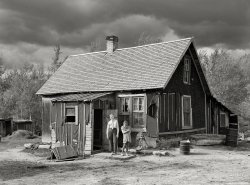
- Porksicle: 1940
- ... be done here. This co-op received a $4,500 loan from the Farm Security Administration." Photo by John Vachon. View full size.
Body ... Posted by Dave - 12/05/2019 - 6:46pm -
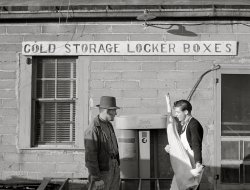
- Kiewel Beer: 1940
- ... Dakota." 35mm nitrate negative by John Vachon for the Farm Security Administration. View full size.
A different use for grain ... Posted by Dave - 11/16/2011 - 11:45am -
![Kiewel Beer: 1940 October 1940. "Grand Forks, North Dakota." 35mm nitrate negative by John Vachon for the Farm Security Administration. View full size.
A different use for grainInstead of selling beer, that location is home to a bakery. The Dotty Dunn hat store was at 17 N. 3rd Street. It, the bar and the dry cleaners are all gone, even the cut rate store to the left. The only building that survives is the one to the extreme right. Which appears to have a barber shop. BTW, Dotty Dunn Hats was a chain store operation.
View Larger Map
BarrenOnce again, like the Chicago photo, few people and an angle chosen that makes it seem that you're looking down on a detailed area of a really cool O-gauge layout. Perhaps that's what Vachon was trying to capture.
Bull City Boy has a great question, what is that automobile? A totally different look from the others. I haven't clue alas, [Lincoln Zephyr?] but now I gotta find out. What is it?
Anywhere, U.S.A.Nostalgic picture which is so similar to the small town in which I grew up but on the East Coast. Our businesses on Main Street (with the same kind of diagonal parking before meters) were Carroll Cut Rate, Adam's Hats,Gene's Bar featuring Rheingold beer, Pete's Barber Shop and Bashura's Shoe Repair. I used to love the fumes in the shoemakers and cleaners, both now deemed very lethal, i.e. shoe polish, glues, leather-tanning chemicals and carbon tetrachloride. We also had a Hart's Five and Dime and a First National grocery. Kind of neat to think that whether you grew up in the East or Midwest, the small town Main Streets were so similar.
Brew NotesAs a side note, Kiewel's Beer was brewed in Little Falls, Minnesota, while Heileman's Old Style (hanging sign over the tavern door) was brewed in La Crosse, Wisconsin.
Interior HingesSo, is no one going to identify the autos, especially the fourth from the left?
P.S. I've been away for five weeks. Glad to be back and I'll be catching up with Shorpy as best I can.
Inflation$1.98 in 1940 would be about $32 today. Not a bad price for a man's hat.
Cars ID'dFrom left,
1940 Chevy with deluxe rear center guard.
1937-38 Chrysler
1937 Nash
1939 Chrysler?
1940 Oldsmobile
Comments welcome.
The vehicle 4th from the left is a 1939 Ford Deluxe 2 door sedan. Better later than never.
(The Gallery, Cars, Trucks, Buses, John Vachon)](https://www.shorpy.com/files/images/SHORPY_8a32539a.thumbnail.jpg)
- Howard Stove Works: 1941
- ... Medium format negative by Jack Delano for the Farm Security Administration. View full size.
A fire waiting to happen Looks quite ... Posted by Dave - 04/06/2022 - 4:15pm -
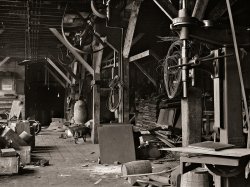
- Freeze Frame: 1940
- ... Medium format negative by Arthur Rothstein for the Farm Security Administration. View full size.
Not to be Negative, But ... Posted by Dave - 01/25/2018 - 8:58pm -
![Freeze Frame: 1940 January 1940. "Marion Post Wolcott [last seen here] with Ikoflex and Speed Graphic in hand in Montgomery County, Maryland." Medium format negative by Arthur Rothstein for the Farm Security Administration. View full size.
Not to be Negative, But@TomD: Possibly because the Eastman-Safety-Kodak imprint would be not-backwards on the negative, thus backwards on the positive print.
[Every negative (or any transparent sheet) has two sides you can read it from. One side will always be "backwards." If you flip the film over, the EASTMAN SAFETY KODAK is no longer reversed. The KODAK imprint and the photographic image are backwards relative to each other by design. The imprint shows you which side needs to face up (showing KODAK and not KADOK) when you put it in the enlarger, to keep your print from coming out backwards. Both the backward image and rightward KODAK reverse when they are projected through the enlarger lens, giving a rightward image and backward KODAK on the resulting print. - Dave]
Backwards AND forwards?Wondering how the Shorpy watermark and the film disgnation are both backwards while the names on the cameras are correct? It's a mystery!
[Another mystery: What's a "disgnation"? - Dave]
Anti-Gravitational ThreesomeNot only does this photo "color" the work and personas of Ms. Wolcott and Mr. Rothstein, it captures an invisible moment of time.
Moments after Mr. Rothstein said "watch the birdie" (or something similar), and Ms. Wolcott "smiled for the camera", and just as Mr. Rothstein released the shutter, along came a gust of wind.
The wind blew back the flap of Ms. Wolcott's coat. At the same time, the wind blew forward locks of her hair, causing her to shut (shutter?) her right eye in sync with Mr. Rothstein's shutter. All caught on a single frame of film.
An innocent, playful moment of two photographers and Mother Nature, caught forever on Kodak/Kadok film.
A touching image! Great Shorpy choice!
Imprint confusionConfusion may be occurring because those familiar only with roll film and 35mm aren't aware that Kodak used a different convention with sheet film.
With sheet film, the "imprint" was embossed as was right-reading when you viewed the emulsion side. This would appear reversed on a proper print. This imprint is outside of the standard print area and not expected to be reproduced, though most holders allowed extra image to bleed into that area and Dave chooses to include it in his scans.
With roll films, 35mm, and other small formats, Kodak exposes the information in the light sensitive emulsion instead of embossing the plastic base. The convention here is different with the imprint being right reading when you are viewing the base side. It therefore prints as right reading when the image is printed correctly should it be included in a print, though it is again outside of the standard printing area.
Photographers' DilemmaI know the feeling. The camera loaded and ready and it's winter and there's nothing to photograph, no matter how much you walk around looking for something.
I had a 2 1/4 x 3 1/4 Speed Graphic and a Leica F with bulk film, and a darkroom, as a kid.
But there's nothing out there.
The Weston meterI believe Ms. Wolcott has a Weston Photronic 650 exposure meter hanging from a lanyard, right next to her Zeiss Ikoflex. My much-later Weston Master V lived on a lanyard very similar.
Pleasant LadyThis and earlier images of Ms. Wolcott posted make me think she has a very pleasant disposition and enjoyed what she was doing.
BootsUnless she has on some heavy woollen socks, her feet will soon be getting cold in these uninsulated rubber rain boots.
Re Pleasant Lady: I agree, what a lovely cutie!
Re: Pleasant LadyWhat a treat to see the delightful person on the other side of the photographs. We spend so much time scrutinizing their pictures here on Shorpy that it's definitely gratifying to see who's taking them.
My wife points out that her toes will be getting chilly in those thin rubber boots unless she's got big woollen socks on.
A different angleWe've seen Ms. Wolcott from other vantage points as well. A cutie, indeed!
More Marion, Please!I just can't get enough of Marion Post Wolcott.
GayteesShe wasn't necessarily freezing in those rubber boots.
(The Gallery, Arthur Rothstein, M.P. Wolcott)](https://www.shorpy.com/files/images/SHORPY-8b19319a.thumbnail.jpg)
- Beer Depot: 1941
- ... format acetate negative by Marion Post Wolcott for the Farm Security Administration. View full size.
More Filling Leadville was ... Posted by Dave - 10/31/2021 - 11:59am -
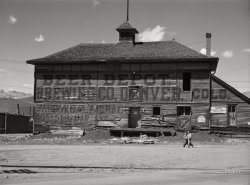
- Crossville Loafers: 1937
- ... full size. 35mm nitrate negative by Ben Shahn for the Farm Security Administration.
Loafers The Rexall drugstore was the hangout in ... Posted by Dave - 09/09/2011 - 11:22am -
![Crossville Loafers: 1937 1937. "Men loafing. Crossville, Tennessee." View full size. 35mm nitrate negative by Ben Shahn for the Farm Security Administration.
LoafersThe Rexall drugstore was the hangout in every town back then. In fact, out west they had a name for fake cowboys who never saw a cow but dressed the part: "Rexall Cowboys." They usually had a soda fountain in these stores, so the proprietor wanted people hanging around. In a small town, everyone knew everyone else, so there was no fear entering the Rexall through the crowd.
Vacation SpecialIt was a toothbrush and carrying case combo. Both only 50 cents!
Ex-LaxI like the Ex-Lax clock (or thermometer?) on the left side.
[It looks like a clock. So the sidewalk loafers had no excuse for not knowing when it was time to, um, go. - Dave]
Window ShoppingKinda hard to do any window shopping at that drug store with a group of men sitting in front of the display windows. It's almost like running the gantlet to enter the store. Wonder why the architect/builder intentionally put those ledges in front of the show windows? Surely they must have known people would promptly sit down on them.
Dr. West and his vaccination special I am guessing that Dr West went to medical school with Dr. Scholl and Dr Pepper, but what is the "Vaccination Special"?
[It's what you get before going on vacation. - Dave]](https://www.shorpy.com/files/images/8a17090u_0.thumbnail.jpg)
- Baby Vegetables: 1940
- July 1940. "Canning beans in farm kitchen near Bristol, Vermont." Photo by Louise Rosskam for the Farm Security Administration. View full size.
All growed up - and then some Our ... Posted by Dave - 08/01/2012 - 4:54am -
![Baby Vegetables: 1940 July 1940. "Canning beans in farm kitchen near Bristol, Vermont." Photo by Louise Rosskam for the Farm Security Administration. View full size.
All growed up - and then someOur cheerful baby would now be 73 years old. It would be nice to see a photo of her (him?) today. Google People View?
Old things!Oilcloth and enamel pots and pans. Two neat old things you just don't see anymore.
May I join you?This is one of those pictures I sure wish I could walk into and join the action! It brings back lots of memories of canning various fruits and veggies, with my mother-in-law, sisters-in-law, and various friends. It's a big job, but a lot of fun, if there is good company, during it. Not much is so gratifying as seeing rows of filled jars, from the Summer and Fall bounty, knowing that one's family will benefit from it when there is snow on the ground!
1940?The calendar on the wall reads "1937."
[Being used for decor. Below, a shot a few frames away on the same roll. - tterrace]
BabyThat's about the most gleefully happy baby I've seen in one of these pictures. Must be thinking about eating those beans.
Let's see that calendarCan you zoom in on that calendar? It almost looks like it says "C. A. Donah" on it.
[Alas, it's not clear on the the full-size original. - tterrace]
Well-ShodMom and Grandma wearing some nifty shoes.
(The Gallery, Kids, Kitchens etc., Louise Rosskam)](https://www.shorpy.com/files/images/SHORPY_8b30802a.thumbnail.jpg)
- Sky Chief: 1942
- ... Medium format acetate negative by John Vachon for the Farm Security Administration. View full size.
Die and pay taxes Taxes ... Posted by Dave - 02/23/2022 - 1:22pm -
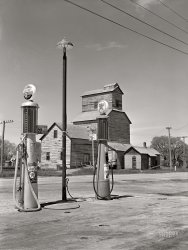
- Harrowed Ground: 1941
- ... Medium format acetate negative by Russell Lee for the Farm Security Administration. View full size.
Excellent title! Driving on ... Posted by Dave - 02/28/2022 - 12:02pm -
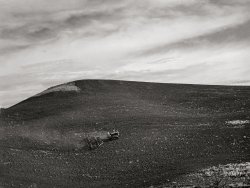
- Oklahoma: 1940
- February 1940. "Farm boys at play party in McIntosh County, Oklahoma." Safety negative by Russell Lee for the Farm Security Administration. View full size.
Happy Days Of the five people in the ... Posted by Dave - 09/13/2011 - 2:27pm -
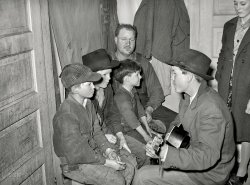
- Log Train Running: 1941
- ... Medium format acetate negative by Russell Lee for the Farm Security Administration. View full size.
Hardpack Harvest No doubt ... Posted by Dave - 02/08/2022 - 4:52pm -
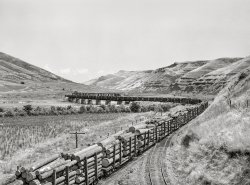
- Let's Eat: 1943
- August 1943. "Middle River, Maryland. A Farm Security Administration housing project for Glenn L. Martin aircraft workers. A worker's ... Posted by Dave - 10/06/2013 - 12:18pm -
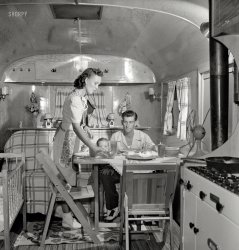
- Okie Near Muskogee: 1939
- ... View full size. 35mm nitrate negative by Russell Lee, Farm Security Administration.
Vintage Ford Truck Just look at the way he ... Posted by Dave - 12/10/2007 - 1:42pm -
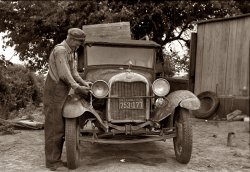
- Diapers Online: 1941
- ... home on Carson Street. Sunset Village, Radford, Virginia. Farm Security Administration project." Where it looks like laundry day. Medium-format nitrate ... Posted by Dave - 11/18/2012 - 2:20pm -
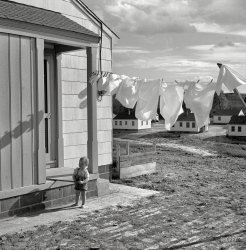
- Moving Day: 1938
- ... Medium format acetate negative by Sheldon Dick for the Farm Security Administration. View full size.
Right There in Manhattan I ... Posted by Dave - 10/07/2018 - 10:10am -
![Moving Day: 1938 New York, 1938. "East 62nd Street." Medium format acetate negative by Sheldon Dick for the Farm Security Administration. View full size.
Right There in ManhattanI spy some great gasometers lurking in the distance.
The 2 Round Towers Does anybody know what those two, apparently round, structures are there were being built at the end of E. 63rd down by the water?
I've tried finding out online but to no avail.
[Those are gas holders, also known as gasometers, and they're not under construction. - Dave]
Those trousers!Can anyone share any insight into that pair of pants? Was that a style? Born of necessity? Please advise.
There's a lot of fabric in those pantsWas this style popular circa 1938?
East 62nd, not 63rdBetween Second and First avenue as this 1930 Plat map of Manhattan shows the Bristol company on 62nd Street.
http://www.historicmapworks.com/Map/US/16723/Plate+105/Manhattan+1930+La...
Split apronThe mover appears to be wearing a split apron similar to a farrier's apron. It allows you to bear loads on the front of your thighs while protecting your trousers and your skin from punctures and abrasion.
Not Pants?I can remember trashmen in Philadelphia in the mid 1950s wearing that kind of heavy cloth leg apron that didn't go above the waist. I think a trashman character in the Snuffy Smith comic strip also wore it.
Fill 'er up!As a young boy, my father and I drove past a gasometer. There were several men sitting on top of the bladder with their legs hanging over the side. My father said they were filling it up. It's easy to fool a kid when he adores his father.
Rubber NeckersI know there have been other photos showing people watching life go by from their windows, but this is one of the few I remember. I've always thought it odd that more people didn't keep an eye on that stranger in the 'hood with a camera.
Wonder WomanI wonder what the woman on top of that building was doing - aside from making me nervous -- 80 years later.
[This might be a good opportunity to investigate the difference between "woman" and "women." - Dave]
Ahhh... isn't it great when it's never too late to learn singular from plural?!
Heavens to BetsyI hope she isn't going to jump!
Still there (mostly)Looking at Google Maps Street View, the building that housed The Bristol Co. at 319 E. 62nd Street is still there, as is the building across the street at 316 (although one half of the parapet has strangely disappeared):
(The Gallery, Cars, Trucks, Buses, NYC, Sheldon Dick)](https://www.shorpy.com/files/images/SHORPY-8c35313a.thumbnail.jpg)
- Dakota Station: 1940
- ... Medium format acetate negative by John Vachon for the Farm Security Administration. View full size.
Correction That's Baby ... Posted by Dave - 12/18/2019 - 8:31pm -
